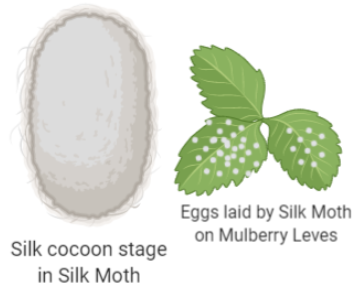
Female Silk Moth lays __________
A. 50-100 eggs
B. 200-250 eggs
C. 350-400 eggs
D. 800-1000 eggs
Answer
561k+ views
Hint: A silk Moth is a large-sized moth that usually is white in color and produces silk in its cocoon stage. Silk Moth eggs are like tiny white dots. Moreover, a butterfly lays around 200 eggs but Silk Moth lays double the amount of eggs as the butterfly.
Complete step by step answer: The silk moth’s life cycle is much like a butterfly. But the difference is that the cocoon it produces is made of silk. It is a large moth with a caterpillar stage that protects itself by a silken cocoon. The lifecycle of silk moth begins from eggs laid by female silk moths, usually more than 350 eggs on mulberry leaves. The eggs hatch to give rise to the caterpillar stage of the silk moth. This caterpillar then feeds on mulberry leaves and turns into a pupa. In this stage, it wraps itself by spinning a fiber made of a protein called silk fiber. This is called a cocoon. After some time the cocoon matures and an adult silk moth hatches which lays 350-400 eggs in clusters on mulberry leaves. By this, the lifecycle again begins.

Hence, the right answer is option C.
Note: Silk moth is a primary source of obtaining silk fiber. The extraction of silk from the cocoon stage of the silk moth is called the processing of silk. After the silk is separated from the cocoon, it is exposed to sunlight. Then the reeling of silk is done and unwinding of silk from the cocoon is done.
Complete step by step answer: The silk moth’s life cycle is much like a butterfly. But the difference is that the cocoon it produces is made of silk. It is a large moth with a caterpillar stage that protects itself by a silken cocoon. The lifecycle of silk moth begins from eggs laid by female silk moths, usually more than 350 eggs on mulberry leaves. The eggs hatch to give rise to the caterpillar stage of the silk moth. This caterpillar then feeds on mulberry leaves and turns into a pupa. In this stage, it wraps itself by spinning a fiber made of a protein called silk fiber. This is called a cocoon. After some time the cocoon matures and an adult silk moth hatches which lays 350-400 eggs in clusters on mulberry leaves. By this, the lifecycle again begins.

Hence, the right answer is option C.
Note: Silk moth is a primary source of obtaining silk fiber. The extraction of silk from the cocoon stage of the silk moth is called the processing of silk. After the silk is separated from the cocoon, it is exposed to sunlight. Then the reeling of silk is done and unwinding of silk from the cocoon is done.
Recently Updated Pages
Master Class 12 Business Studies: Engaging Questions & Answers for Success

Master Class 12 Economics: Engaging Questions & Answers for Success

Master Class 12 English: Engaging Questions & Answers for Success

Master Class 12 Maths: Engaging Questions & Answers for Success

Master Class 12 Social Science: Engaging Questions & Answers for Success

Master Class 12 Chemistry: Engaging Questions & Answers for Success

Trending doubts
What are the major means of transport Explain each class 12 social science CBSE

Which are the Top 10 Largest Countries of the World?

Draw a labelled sketch of the human eye class 12 physics CBSE

How much time does it take to bleed after eating p class 12 biology CBSE

Explain sex determination in humans with line diag class 12 biology CBSE

Differentiate between homogeneous and heterogeneous class 12 chemistry CBSE




